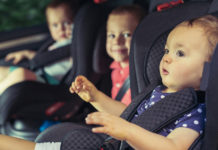Thinking of buying the kids a furry pet for Christmas? Before you make that spur-of-the-moment decision, remember that the playful puppy or cute kitten you are about to buy will probably be around long after the kids have moved out of home! Take the time to consider whether you and your family are ready for the dedication, time and financial commitment that a pet requires.
Before lumping you with the hard facts about what your latest addition will mean for your family, consider why 63% of Australian households currently own a pet. A pet brings excitement, joy and companionship along with physical and mental health benefits to everyone in the family. Pet ownership has been found to improve minor health ailments, reduce anxiety, loneliness, depression, stress and risk factors for obesity and cardiovascular disease. If you have children, the addition of a dog to the family decreases the risk of obesity and allergies linked to asthma, as well as enhances the individual’s social and emotional development. Kids learn a sense of respect for animals and responsibility in life, as long as they are held to it!
The Hard-hitting Reality
Now to the hard-hitting reality: In 2011, over 67,000 dogs and 64,000 cats were surrendered to the RSPCA in Australia. In the weeks following Christmas, the number of dumped kittens and puppies increase by up to 15%. These are the cute, cuddly, perfect presents that soon become unwanted, as their new owners are not prepared to care for them. So whilst it doesn’t need to be a pet-free Christmas, be sure to make an informed decision. When trying to decide if you have what it takes to be a good pet owner, make sure you consider whether you:
- have enough time for a pet;
- are prepared to care for a pet for its whole life;
- can afford a pet;
- have living arrangements suitable for a pet;
- have a lifestyle which can accommodate a pet; and
- believe a pet would be appropriate for your kids.
Do I have enough time for a pet?
Pets require time and patience just like any other member of your family. They need to be exercised, socialised, trained, groomed, cleaned up after and genuinely loved. Whilst we all have good intentions of ensuring kids take responsibility for their pets, statistics show that the major carer of the pet is female and married with children. If you work full-time or have a household of children and chores, chances are cleaning up poo from the backyard and taking Fido for a run is the last thing you feel like doing.
Am I prepared to care for a pet for its whole life?
Given how effortless it is to buy a pet, it is very easy to forget that the new addition to your family will be around for an average of 12 years. Cats can even reach their 20s! Much to the many peoples’ dismay (children in particular), puppies and kittens don’t stay fluffy and cute forever. You need to be prepared to care for your animal as it grows into an adult and eventually reaches old-age. Just like people, animals can become incontinent, suffer from chronic arthritis, lose teeth and gain stinky breath! When the time comes, be aware that it is often devastating for a child to say goodbye to their beloved, family pet. Whilst it seems a little premature to be considering this before you have even chosen the animal, you need to be prepared to deal with the difficulty of death and euthanasia.
Can I afford a pet?
Owning a pet costs money, and at times, lots of it! From the outset, you will need to buy bedding, food, collars, leads and toys to ensure your pet has everything they need to settle into their new home. Then you will need to consider the cost of vaccination, worming, microchipping, desexing, puppy pre-school/training, grooming, boarding, insurance and vet bills. Many owners underestimate the hidden costs associated with replacing items such as reticulation or a new pair of shoes that the new puppy decided to chew through. Generally, the larger the animal, the greater the cost!
Will my living arrangements accommodate a pet?
Housing trends are changing, with many people residing in apartments and houses built on cottage blocks with no backyard. Rental properties often do no permit pet ownership, making it difficult for you to move to a new residence and have your pet stay with you. Whilst 63% of all Australian households own pets, less than 17% of rental households are among these. If you live in a share-house be sure that your housemates are consulted on your decision to buy a pet. Approximately 15% of people are allergic to animals and others have a genuine fear of various species.
Will a pet fit into my lifestyle and priorities?
Every pet needs a lot of love and attention, no matter what species or age. Long working hours, a busy social life and regular holidays are all factors that need to be considered before purchasing a pet. Quite simply, boredom is a recipe for bad behaviour! Dogs left alone will develop a penchant for barking, digging up the backyard and destructive behaviour. This drives neighbours up the wall and leaves owners feeling stressed and anxious whenever they leave the house. You also need to consider whether having a pet is going to impact on your family holidays. If you choose to head away and leave the pet behind, you will need to make sure they are looked after adequately. If you do not have family or friends that can help out, you will need to enlist the services of a boarding kennel. For an average dog, this will set you back a minimum of $140/week. Suddenly, your cheap camping trip just became unexpectedly expensive.
Will a pet be appropriate for my kids?
Care must always be taken when animals and children come into contact, as kids simply have no understanding of the potential danger they may pose. No dog should ever be trusted with babies and small children alone, no matter how well you know them. Whilst most people are aware that a number of dog breeds are declared dangerous and are not suitable as family pets, the risk associated with smaller pets can often be overlooked. Toy and small breeds, such as the Chihuahua, can often be nervous and snappy. Some animals react undesirably to fear, pain or competition at the food bowl. You must always teach your children to remain calm and quiet around pets and never tease, hurt or corner the animal. Only you know your children well enough to decide whether their temperament will suit having an animal.
Whilst children reap many benefits from owning a pet, there are times when kids and animals just don’t mix for health reasons. Some children suffer from severe allergies and cannot be around certain species or breeds of animals. A pet allergy occurs when the immune system reacts to a specific foreign substance found in skin flakes, saliva and urine of animals or the pollen, mold and dust that collects in an animal’s coat. Cat allergies are approximately twice as common as dog allergies. You need to be particularly aware of this if your child suffers from other allergies or is asthmatic, as both groups tend to have a higher incidence of animal allergies.
Purchasing a pet should never be an impulsive decision. While owning a pet can be extremely rewarding, it is important to remember that pet ownership is also a huge responsibility. It can be very hard to resist the playful puppy or cute kitten at the local pet store, especially when you have children begging you with their own puppy dog eyes, but remember one thing – pets may be easy to purchase but looking after them is not always a walk in the park (pardon the pun)! If you have come this far and are still keen to buy a pet, then chances are they will make a wonderful addition to the family. Be sure to buy your animal from a reputable breeder and choose a breed that best suits your family and lifestyle.
Kindly written and reviewed by Dr Abbey Potter BSc (Hons) BVMS PhD, Lecturer in Physiology, Murdoch University, Western Australia and Registered Veterinarian.
References
- AAFA – Asthma and Allergy Foundation of America (2005). Pet Allergies. Available from: URL Link
- ABC Adelaide: No pets please plea for Christmas presents – RSCPA Interview (2010). Available from: URL Link
- ACAAI – The American College of Allergy, Asthma and Immunology. Pet Allergies Information. Available from: URL Link
- ACAC – The Australian Companion Animal Council Inc. (2009) The Power of Pets: The Benefits of Companion Animal Ownership. Available from: URL Link
- Anderson, W. P. and G. L. Jennings (1992). “Pet ownership and risk factors for cardiovascular disease.” The Medical Journal of Australia 157(5): 298-301. (Abstract).
- Boston Children’s Hospital (2012) Animal allergy. Available from: URL Link
- Crowley-Robinson, P., D. C. Fenwick, et al. (1996). “A long-term study of elderly people in nursing homes with visiting and resident dogs.” 47(1): 137-148. (Abstract).
- Cutt, H. E., M. W. Knuiman, et al. (2008). “Does getting a dog increase recreational walking?” International Journal of Behavioral Nutrition and Physical Activity 5(17). (Full text).
- Filiatre, J. C., J. L. Millot, et al. (1986). “New data on communication behaviour between the young child and his pet dog.” Behavioural Processes 12(1): 33-44. (Full text)
- Gern, J. E., C. L. Reardon, et al. (2004). “Effects of dog ownership and genotype on immune development and atopy in infancy.” Journal of Allergy & Clinical Immunology 113(2): 307-314. (Full text)
- Jennings, L. B. (1997). “Potential benefits of pet ownership in health promotion.” Journal of Holistic Nursing 15(4): 358-372. (Abstract).
- Petcare Information and Advisory Service (2012). Pet Statistics. Available from: URL Link
- RSPCA Australia (2011). Annual Statistics. Available from: URL Link
- Serpell, J. (1991). “Beneficial effects of pet ownership on some aspects of human health and behaviour.” Journal of the Royal Society of Medicine 84(12): 717-720. (Full text).
- Siegel, J. M. (1990). “Stressful life events and use of physician services among the elderly: the moderating role of pet ownership.” Journal of Personality and Social Psychology 58(6): 1081-1086. (Abstract).
- Timperio, A., J. Salmon, et al. (2008). “Is dog ownership or dog walking associated with weight status in children and their parents?” Health Promotion Journal of Australia 19(1). (Abstract).










